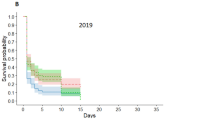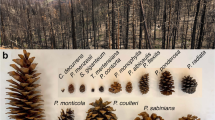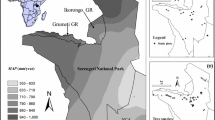Abstract
All individuals of all known populations of Banksia goodii were assessed for seed production. Small populations produced no or only a few seeds per unit canopy area. Effects of population size on seed production per unit area and seed production per plant were present over the whole range of population sizes, indicating that even in large populations seed production may still not be at its maximum. Resource differences could not explain this disproportionate decrease in seed production with decline in population size, because there were no differences in soil properties and understorey or overstorey cover between the small and large populations. Although plants in small and large populations were similar in size, seed production per plant was much lower in small populations. This was not because plants in small populations produced fewer cones but because the fraction of these cones that was fertile was much lower. Five of the nine smallest populations (<200 m2) produced no fertile cones over the last 10 years. The number of seeds per fertile cone did not depend on population size. The results are discussed in relation to pollination biology.
Similar content being viewed by others
References
Allee WC (1949) Group survival value for Philodina roseola, a rotifer. Ecology 30:395–397
Burgman MA, Ferson S, Akçakaya HR (1992) Risk assessment in conservation biology. Chapman and Hall, London
Collins BG, Newland C (1986) Honeyeater population change in relation to food availability in the jarrah forst of Western Australia. Aust J Ecol 11: 63–76
Collins BG, Spicc J (1986) Honeyeaters and the pollination biology of Banksia prionotes (Proteaccae). Aust J Bot 34:175–185
Collins BG, Briffa P, Newland C (1984) Temporal changes in abundance and resource utilization by honeyeaters at Wongamine Nature Reserve. Emu 84: 159–166
Copland BS, Whelan RS (1989) Seasonal variation in flowering intensity and pollination limitation of fruit set in four co-occurring Banksia species. J Ecol 77:509–523
Fuss AM, Sedgley M (1991) Pollen tube growth and seed set of Banksia coccinea R. Br. (Proteaceae). Ann Bot 68:377–384
Jennersten O (1988) Pollination in Dianthus deltoides (Caryophyllaceae): effects of habitat fragmentation on visitation and seed set. Conserv Biol 2:359–366
Klinkhamer PGL, Jong TJ de (1990) Plant size and pollinator visitation in Cynoglossum officinale. Oikos 54:201–204
Klinkhamer PGL, Jong TJ de, Meelis E (1990) How to test for proportionality in the reproductive effort of plants? Am Nat 135:291–300
Klinkhamer PGL, Meelis E, Jong TJ de, Weiner J (1992) On the analysis of size-dependent reproductive output in plants. Funct Ecol 6:308–316
Lamont BB, Collins BG (1985) Flower colour change in Banksia ilicifolia: a signal for pollinators. Aust J Ecol 15:129–135
Lamont BB, Connell SW, Bergl S (1991) Population and seed bank dynamics of Banksia cuneata: the role of time, fire and moisture. Bot Gaz 152:114–122
Lande R, Barrowclough GF (1987) Effective population size, genetic variation, and their use in population management. In: Soulé ME (ed), Viable populations for conservation. Cambridge University Press, Cambridge, pp 87–123
Lesica P, Allendorf FW (1992) Are small populations of plants worth preserving? Conserv Biol 6:135–139
Mehroff LA (1983) Pollination in the genus Isotria (Orchidaceae), Am J Bot 70:1444–1453
Ramsey M, Vaughton G (1991) Self-incompatibility, protandry, pollen production and pollen longevity in Banksia menziesii. Aust J Bot 39:497–504
Rathke B (1983) Competition and facilitation among plants for pollination. In: Real L (ed), Pollination Ecology. Academic Press, New York
Recher HF, Serventy DL (1991) Long term changes in the relative abundances of birds in Kings Park, Western Australia. Conserv Biol 5:90–102
Schemske DW (1980) Floral ecology and hummingbird pollination of Combretum farinosum in Costa Rica. Biotropica 12:169–181
Scott JK (1980) Estimation of the outcrossing rate for Banksia attenuata R. Br. and Banksia manziesii R. Br. (Proteaceae) Aust J Ecol 28:53–59
Sowig P (1989) Effects of plant's patch size on species composition of pollinator communities, foraging strategies, and resource partitioning in bumblebees (Hymenoptera: Apidae). Oecologia 78:550–558
Stock WD, Pate JS, Kuo J, Hansen AP (1989) Resource control of seed set in Banksia laricina C. Gardner (Proteaceae). Funct Ecol 3:453–460
Taylor A, Hopper S (1988) The banksia atlas. Aust Gort Pub Serv, Canberra
Wallace DD, O'Dowd DJ (1989) The effect of nutrients and inflorescence damage by insects on fruit set by Banksia spinulosa. Oecologia 79:482–488
Whelan RJ, Goldingay RL (1986) Do pollinators infuence seed-set in Banksia paludosa R. Br. Aust J Ecol 11:181–186
Author information
Authors and Affiliations
Rights and permissions
About this article
Cite this article
Lamont, B.B., Klinkhamer, P.G.L. & Witkowski, E.T.F. Population fragmentation may reduce fertility to zero in Banksia goodii — a demonstration of the Allee effect. Oecologia 94, 446–450 (1993). https://doi.org/10.1007/BF00317122
Received:
Accepted:
Issue Date:
DOI: https://doi.org/10.1007/BF00317122




